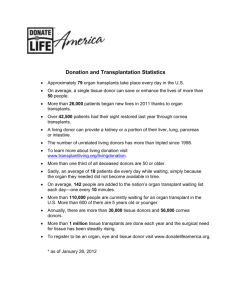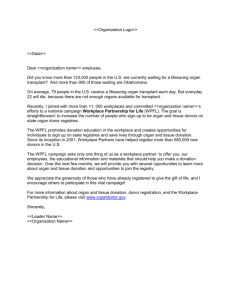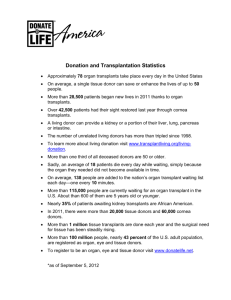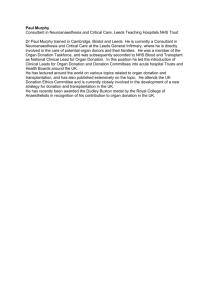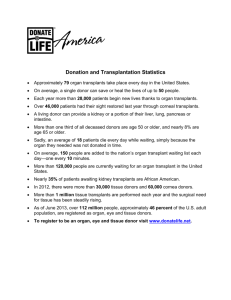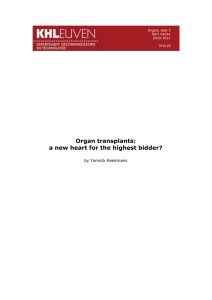HW4 Organ Donation/Transplant Assignment
advertisement
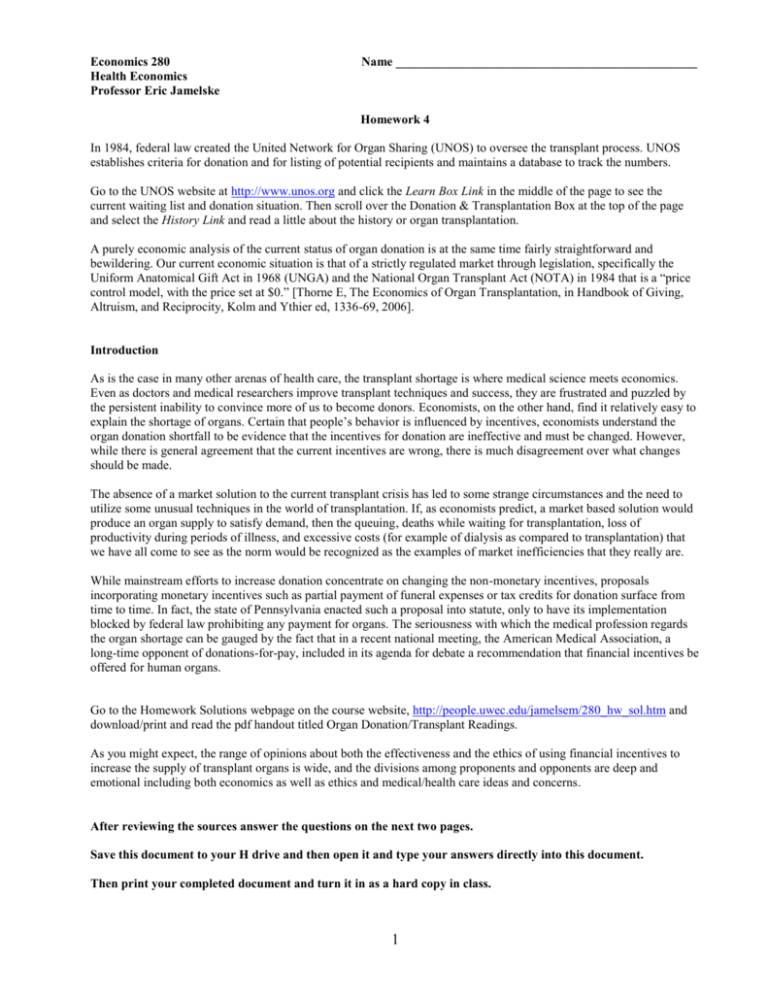
Economics 280 Health Economics Professor Eric Jamelske Name ________________________________________________ Homework 4 In 1984, federal law created the United Network for Organ Sharing (UNOS) to oversee the transplant process. UNOS establishes criteria for donation and for listing of potential recipients and maintains a database to track the numbers. Go to the UNOS website at http://www.unos.org and click the Learn Box Link in the middle of the page to see the current waiting list and donation situation. Then scroll over the Donation & Transplantation Box at the top of the page and select the History Link and read a little about the history or organ transplantation. A purely economic analysis of the current status of organ donation is at the same time fairly straightforward and bewildering. Our current economic situation is that of a strictly regulated market through legislation, specifically the Uniform Anatomical Gift Act in 1968 (UNGA) and the National Organ Transplant Act (NOTA) in 1984 that is a “price control model, with the price set at $0.” [Thorne E, The Economics of Organ Transplantation, in Handbook of Giving, Altruism, and Reciprocity, Kolm and Ythier ed, 1336-69, 2006]. Introduction As is the case in many other arenas of health care, the transplant shortage is where medical science meets economics. Even as doctors and medical researchers improve transplant techniques and success, they are frustrated and puzzled by the persistent inability to convince more of us to become donors. Economists, on the other hand, find it relatively easy to explain the shortage of organs. Certain that people’s behavior is influenced by incentives, economists understand the organ donation shortfall to be evidence that the incentives for donation are ineffective and must be changed. However, while there is general agreement that the current incentives are wrong, there is much disagreement over what changes should be made. The absence of a market solution to the current transplant crisis has led to some strange circumstances and the need to utilize some unusual techniques in the world of transplantation. If, as economists predict, a market based solution would produce an organ supply to satisfy demand, then the queuing, deaths while waiting for transplantation, loss of productivity during periods of illness, and excessive costs (for example of dialysis as compared to transplantation) that we have all come to see as the norm would be recognized as the examples of market inefficiencies that they really are. While mainstream efforts to increase donation concentrate on changing the non-monetary incentives, proposals incorporating monetary incentives such as partial payment of funeral expenses or tax credits for donation surface from time to time. In fact, the state of Pennsylvania enacted such a proposal into statute, only to have its implementation blocked by federal law prohibiting any payment for organs. The seriousness with which the medical profession regards the organ shortage can be gauged by the fact that in a recent national meeting, the American Medical Association, a long-time opponent of donations-for-pay, included in its agenda for debate a recommendation that financial incentives be offered for human organs. Go to the Homework Solutions webpage on the course website, http://people.uwec.edu/jamelsem/280_hw_sol.htm and download/print and read the pdf handout titled Organ Donation/Transplant Readings. As you might expect, the range of opinions about both the effectiveness and the ethics of using financial incentives to increase the supply of transplant organs is wide, and the divisions among proponents and opponents are deep and emotional including both economics as well as ethics and medical/health care ideas and concerns. After reviewing the sources answer the questions on the next two pages. Save this document to your H drive and then open it and type your answers directly into this document. Then print your completed document and turn it in as a hard copy in class. 1 1. List several factors that you believe contribute to too few organ donations. Hint: Consider the top ten myths. 2. Economists have established that people respond to incentives. Do you think that offering financial incentives for organ donation would overcome the factors you listed in question one? Briefly explain. 3. What is the opportunity cost of not allowing financial incentives for organ donations? Very briefly explain. 2 4. What other alternatives to financial incentives could possibly work to increase organ donations? Briefly explain. What if it were up to you, should we solve the human transplant organ shortage with $? Brainstorm the issues and list some pros and cons of offering financial incentives for donating human organs. Then take a side in the debate and write a short paragraph or two supporting your position. We will have a class discussion/debate. Remember, there is not a right or wrong answer. 3 Data Collection: Go to the UNOS website (http://www.unos.org/) and collect the data as described below. Go to the Homework Solutions webpage on the course website, http://people.uwec.edu/jamelsem/280_hw_sol.htm and download and save the Excel spreadsheet to your H drive and then use this spreadsheet to store and work with the data. Save your finished spreadsheet with the same file name replacing the # with your group’s actual group #. Turn in your group’s Excel spreadsheet for this assignment by saving this file on the W Drive following this path: W\econ\jamelske\Econ280\Organ_Assignment\Section_### (001, 002 depending on your class section) Donors and Transplants 1. Scroll over the Donation & Transplantation Box on the top of the page and select Data from the drop down menu. 2. Click on the National Data link under the Data Reports heading (this will open a new window). 3. Click on the Build Advanced link on the left of the page under the National Data heading. 4. Select Donor from the 1st drop-down menu. 5. Select Organ (6 items) from the 2nd drop-down menu. 6. Select Donation Year (27 items) and Donor Type (2 items) from the 3rd drop down menu. 7. Select the Go button to get the data. 8. Get the data for All Donors and Kidney for the years 1988-2013. 9. Repeat for Transplants (organ-8 items, transplant year-27 items, donor type-2 items) 10. Get the data for All Organs and Kidney for the years 1988-2013. Waiting List Removal 1. Go back and begin with the National Data link on the left of the page again. 2. Click on the Build Advanced link on the left of the page. 3. Select Waiting List Removal from the 1st drop-down menu. 4. Select Removal Reason (21 items) from the 2nd drop-down menu. 5. Select Removal Year (27 items) from the 3rd drop down menu. 6. Select Candidates (not registrations) from the Optional Count drop down menu on the right. 7. Select the Go button to get the data. 8. Get the data for All Removal Reasons and Died for the years 1995- 2013. Calculations, Graphing and Telling Stories 1. Create a graph(s) telling the story of all organ donors and transplants (living and deceased) over time. 2. Create a graph(s) telling the story of all organ and kidney transplants (living and deceased) over time. 3. Calculate the percent of people on the waiting list that died in the US while waiting for an organ in each year. 4. Calculate the percent of people removed from the waiting list that died while waiting for each year. 5. Create a graph(s) telling the story of death on the waiting list over time. 6. For each of the items above, write a short explanation/interpretation of what the graph(s) show. That is, I want you to observe and describe the situation (positive economic analysis) so that we can use this understanding to guide our discussion of how we can improve this situation (normative economic analysis). 4
